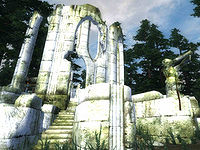Lore:Ceyatatar
| Ceyatatar | |
|---|---|
| Type | Ruin |
| Continent | Tamriel |
| Province | Cyrodiil |
| Region | Great Forest |
| Appears in | Oblivion, ESO |


Ceyatatar (meaning "Shadow of the Fatherwoods" in Ayleidoon,[1] originally named Ceya-Tar) is a crumbling Ayleid ruin in the wilderness between the Imperial City and Skingrad.[2] The ruins contain the central dome of a great underground edifice once dedicated to Magnus, where ancient magic still casts a blue shimmer onto the faded white walls and pools of water within.[1] The underground complex extends deep into the Great Forest to the southwest, having been built into the natural caverns below.[2]
History[edit]
|
In its prime, Ceyatatar was a remarkable city which prospered through trade with the Heartlands around the White-Gold Tower.[3] According to Cyrodilic legend, "Ceya-Tar" was the seat of the Fire King Hadhuul, a particularly cruel Ayleid ruler. In his realms, slaves were drugged with foul concoctions that induced visions of torment, and their children were set aflame for nighttime tiger sport.[4] The sorcerer-king was later slain in single combat on the granite steps of his city by Pelinal Whitestrake during the Alessian Slave Rebellion.[5]
King Hadhuul's spirit, along with spirits of his army and some Flame Atronachs, reappeared at Ceyatatar during the Planemeld in 2E 582, but these invaders were banished by soldiers fighting in the ongoing Alliance War before they could harm the nearby settlement of Vlastarus.[6]
By 3E 433, the ruins of Ceyatatar had been taken over by a group of conjurers and their summoned Daedra, who made use of the ruin's ancient gas chambers to hold and execute captives.[2]
See Also[edit]
- For game-specific information, see the Oblivion and Elder Scrolls Online articles.
References[edit]
- ^ a b Glories and Laments — Alexandre Hetrard
- ^ a b c Ceyatatar in Oblivion
- ^ Ayleid Cities of Valenwood — the Esteemed Historian Homfrey at the University of Gwylim, 2E 455
- ^ The Adabal-a — Morihaus
- ^ The Song of Pelinal
- ^ Essence of Flame quest in ESO